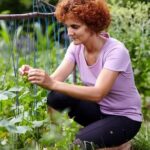Are you looking for some outdoor gardening ideas to spruce up your outdoor space? From beginners to seasoned gardeners, there are endless possibilities for creating a beautiful and thriving outdoor garden. Whether you have limited space or ample room, this article will provide you with tips and inspiration for planning, planting, and maintaining an outdoor garden that suits your lifestyle and preferences.
Outdoor gardening offers a myriad of benefits beyond just adding beauty to your surroundings. It provides an opportunity to connect with nature, reduce stress, and improve mental and physical well-being. In addition, growing your own fruits, vegetables, and herbs can lead to a healthier lifestyle by providing access to fresh produce right from your backyard. With the right tools and knowledge, anyone can create a flourishing outdoor garden that brings joy and satisfaction.
In this section, we will explore the various aspects of outdoor gardening, including planning your garden layout, creative container gardening ideas for those with limited space, easy-to-grow plants for beginners, vertical gardening techniques for maximizing space, as well as seasonal tips for maintaining a beautiful garden year-round. Additionally we’ll cover sustainable practices such as composting and water conservation, as well as incorporating design elements to add personality and style to your outdoor space.
Whether you’re looking for family-friendly activities or simply want to embrace the joy of outdoor gardening as a relaxing hobby – there’s something in store for everyone in this comprehensive guide.
Planning Your Outdoor Garden
When planning your outdoor garden, it’s important to carefully consider the plants you want to grow and the layout of your garden space. Choosing the right plants and arranging them effectively can have a significant impact on the success and visual appeal of your outdoor garden.
Here are some essential tips for choosing the right plants for your outdoor garden:
1. Consider your climate and local conditions: Different plants thrive in different climates, so it’s important to choose plants that are well-suited to your specific region. Consider factors such as sunlight, temperature, and soil type when selecting plants for your outdoor garden.
2. Think about maintenance: When choosing plants for your garden, consider how much time and effort you’re willing to invest in maintenance. Some plants require regular pruning and care, while others are more low-maintenance.
3. Plan for variety: A diverse selection of plants can add visual interest and provide a range of benefits for your outdoor space. Mix flowers, herbs, vegetables, and foliage to create a dynamic and vibrant garden.
4. Take size into account: Consider the mature size of each plant when planning your outdoor garden layout. Make sure to leave enough space for each plant to grow without overcrowding or overshadowing others.
Once you’ve selected the right plants for your outdoor garden, it’s time to think about the layout. Here are some tips for arranging your outdoor garden effectively:
– Create focal points: Use larger or visually striking plants as focal points in your garden design.
– Group similar plants together: Arrange plants with similar needs (such as water or sunlight) in close proximity to make maintenance easier.
– Consider pathways and access: Plan pathways or access points within your garden to make it easy to navigate and tend to all areas.
– Utilize vertical space: If you have limited ground space, consider using vertical elements like trellises or hanging planters to maximize growing area.
With careful planning and consideration, you can create a beautiful and flourishing outdoor garden that reflects your personal style and provides enjoyment year-round.
Creative Container Gardening Ideas for Limited Outdoor Space
Limited outdoor space doesn’t have to limit your gardening possibilities. In fact, container gardening can provide a lot of opportunities for creativity and variety. Here are some creative container gardening ideas for those with limited outdoor space:
- Vertical Gardens: Utilize wall space by installing vertical planters or creating a trellis for climbing plants like tomatoes, cucumbers, or peas.
- Hanging Gardens: Hang baskets from the ceiling or use railing planters to grow herbs, flowers, or even small vegetables in a compact way.
- Repurposed Containers: Get inventive by using old tires, wooden crates, tin cans, or other unconventional containers as planters. This not only adds character to your garden but also helps reduce waste.
When considering what to grow in your limited outdoor space through container gardening, think about the kinds of plants that are suitable for the amount of sunlight and space available. Some great options for container gardening include:
- Herbs: Culinary herbs like basil, mint, and rosemary are perfect for small containers and can be used fresh in your cooking.
- Succulents: These low-maintenance plants come in various colors and textures and thrive in small pots with well-draining soil.
- Dwarf Varieties: Look for compact or dwarf varieties of vegetables such as cherry tomatoes, bell peppers, and bush beans that are bred specifically for small spaces.
By implementing these creative container gardening ideas and choosing the right plants for your limited outdoor space, you can enjoy a beautiful and productive garden even with minimal room to work with.
Outdoor Gardening for Beginners
Outdoor gardening is a fulfilling and rewarding hobby, especially for beginners who are just getting started. It provides numerous benefits, including stress relief, physical exercise, and the satisfaction of growing your own plants. For those new to outdoor gardening, it’s essential to start with easy-to-grow plants and have the right tools on hand.
Easy-to-Grow Plants
When starting your outdoor garden as a beginner, it’s important to choose plants that are low-maintenance and resilient. Some easy-to-grow options include marigolds, sunflowers, zinnias, and herbs like basil and mint. These plants are ideal for beginners as they require minimal care and can thrive in various growing conditions.
Essential Tools
Having the right tools is crucial for successful outdoor gardening. As a beginner, invest in essential tools such as a trowel, pruners, gloves, watering can or hose, and a garden hoe. These basic tools will help you with planting, pruning, watering, and maintaining your outdoor garden effectively.
Tips for Beginners
For those new to outdoor gardening ideas may seem overwhelming at first. However, there are some tips that can make the process easier. It’s important to start small and gradually expand your garden as you gain more experience. Additionally, be sure to learn about the specific needs of each plant you choose to grow in order to provide them with proper care.
By starting with easy-to-grow plants and having the essential tools on hand, beginners can set themselves up for success in their outdoor gardening journey. With time and practice, they can expand their garden and explore more advanced techniques to further enhance their skills.
Maximizing Outdoor Garden Space
When it comes to outdoor gardening, maximizing space is essential, especially for those with limited outdoor areas. Vertical gardening and companion planting are two innovative techniques that can help make the most of your garden space, allowing you to grow a variety of plants in a small area while also promoting healthier plant growth.
Vertical Gardening
Vertical gardening involves growing plants upwards instead of outwards, utilizing walls, fences, trellises, or other structures to support the plants as they grow. This technique not only saves space but also adds visual interest to your garden. Some popular plants for vertical gardening include tomatoes, cucumbers, beans, and various trailing flowers. When planning your vertical garden, consider the weight and size of the plants to ensure the structure can support them as they grow.
Companion Planting
Companion planting is based on the concept that certain plants grown together can benefit each other in terms of pest control, pollination, and even improving flavor. For example, planting marigolds alongside tomatoes can help repel pests that commonly affect tomato plants.
Other classic combinations include planting basil with tomatoes or pairing carrots with onions. By carefully selecting plant combinations that complement each other’s growth habits and needs, you can maximize your outdoor garden space while promoting a healthier and more bountiful harvest.
Tips for Success
When implementing vertical gardening and companion planting in your outdoor garden, it’s important to consider factors such as sunlight exposure, soil quality, and water needs for each plant. Additionally, regular maintenance such as pruning and training vines will be necessary to ensure that your vertical garden remains healthy and productive throughout the growing season.
By incorporating these techniques into your outdoor gardening efforts, you can make the most of limited space while enjoying a diverse and beautiful garden full of thriving plants. Whether you’re growing vegetables or flowers or a combination of both, vertical gardening and companion planting offer creative solutions for maximizing your outdoor garden space.
Seasonal Outdoor Gardening Tips
One of the keys to successful outdoor gardening is understanding the different seasons and how they impact your garden. By carefully planning and maintaining your garden year-round, you can enjoy a beautiful outdoor space no matter the time of year. In this section, we will explore some essential seasonal outdoor gardening tips to help you achieve a thriving garden throughout the year.
In the spring, it’s important to start preparing your garden for the growing season. This may involve cleaning up any debris from the winter months, amending the soil, and starting seeds indoors if necessary. As temperatures warm up, you can begin planting cool-season crops such as lettuce, spinach, and peas. The key to a successful spring garden is to monitor soil moisture and provide adequate sunlight for your plants.
Summer is the time when your garden is in full swing, but it also requires regular maintenance to keep it looking its best. Be sure to water your plants deeply in the early morning or late afternoon to avoid evaporation, and mulch around plants to retain moisture in the soil. Regularly deadhead flowers and harvest vegetables to promote continual growth throughout the season.
As fall approaches, you’ll want to start thinking about transitioning your garden for cooler weather. Begin by removing any spent plants and adding compost or organic matter back into the soil. Consider planting cold-hardy vegetables such as carrots, kale, and Brussels sprouts for a fall harvest. Don’t forget to protect any tender plants from frost by covering them with blankets or row covers.
| Season | Tasks |
|---|---|
| Spring | Cleaning up debris, amending soil, starting seeds indoors, monitoring soil moisture |
| Summer | Watering deeply, mulching around plants, regular deadheading flowers and harvesting vegetables |
| Fall | Removing spent plants, adding compost or organic matter into soil, planting cold-hardy vegetables |
Sustainable Practices for Outdoor Gardening
Composting and water conservation are essential sustainable practices for outdoor gardening that not only benefit the environment but also help to maintain healthy and thriving garden spaces. By incorporating these practices into your outdoor gardening routine, you can reduce waste, conserve water, and nourish your plants naturally.
Composting is a great way to recycle organic waste from your kitchen and yard into nutrient-rich soil for your outdoor garden. By creating a compost pile or using a compost bin, you can turn food scraps, leaves, grass clippings, and other organic materials into valuable humus that enriches the soil and promotes plant growth. This natural fertilizer reduces the need for chemical fertilizers, helps retain moisture in the soil, and supports a healthy ecosystem in your outdoor garden.
In addition to composting, water conservation is an important aspect of sustainable outdoor gardening. By using efficient watering techniques such as drip irrigation or soaker hoses, capturing rainwater in barrels, and planting drought-resistant species, you can minimize water usage while still nurturing your garden. Mulching around plants also helps to retain moisture in the soil and reduce water evaporation.
These practices not only benefit the environment by conserving water but also save time and effort in tending to your outdoor garden. Incorporating composting and water conservation into your outdoor gardening routine can help create a more sustainable and eco-friendly garden space while reducing your environmental footprint. These practices not only benefit the health of your garden but also contribute to a greener planet.
Outdoor Garden Design and Decor
Outdoor gardening is not only beneficial for the environment and your health, but it can also be a great way to add personality and style to your outdoor space. When it comes to outdoor garden design and decor, there are endless possibilities to make your garden truly unique.
One creative idea for adding personality to your outdoor space is by incorporating various types of decor such as sculptures, pottery, or even repurposed items like vintage furniture or old bicycle wheels. These elements can add a touch of whimsy and charm to your garden while showcasing your personal style.
In terms of outdoor garden design, consider creating different sections within your garden using pathways or hedges. This can help create an organized and visually appealing layout. Additionally, using a variety of flowers, plants, and shrubs with different colors and textures can add depth and visual interest to your outdoor space.
Incorporating lighting into your outdoor garden design is another great way to enhance the ambiance of your garden. String lights, lanterns, and solar-powered fixtures not only add an element of magic at night but also extend the usability of your outdoor space into the evening hours.
| Outdoor Garden Design Tips | Decor Ideas |
|---|---|
| Create distinct sections within the garden for visual appeal | Incorporate sculptures or repurposed items for a unique look |
| Use a variety of flowers and plants for texture and color | Add lighting for ambiance and extended usability at night |
Engaging Outdoor Gardening Activities for Children and Families
Outdoor gardening is a wonderful activity that can be enjoyed by people of all ages, especially children and families. It provides numerous benefits such as fostering a love for nature, teaching responsibility, and encouraging healthy eating habits. Engaging children in outdoor gardening also offers valuable learning opportunities about plant life cycles, the environment, and the satisfaction of growing their own fruits and vegetables.
One of the best ways to involve children in outdoor gardening is by assigning them their own small garden plot or container. This gives them a sense of ownership and responsibility for caring for their plants. To make it even more exciting for them, consider choosing fast-growing plants such as sunflowers, radishes, or cherry tomatoes that will provide quick results and keep their interest piqued.
In addition to traditional outdoor gardening, there are plenty of creative activities that can specifically appeal to children and families. For example, creating a fairy garden or themed garden can be a fun project that allows kids to use their imagination while learning about different types of plants.
Another idea is to organize scavenger hunts within the garden to teach children about the diverse plant species present and develop their observation skills. By incorporating these engaging activities into outdoor gardening, families can create lasting memories while enjoying quality time together in the great outdoors.
Conclusion
In conclusion, outdoor gardening offers a multitude of benefits for both the mind and body. It provides an opportunity to reconnect with nature, reduce stress, and enjoy the satisfaction of nurturing plants from seed to harvest. Whether you have limited space or a sprawling backyard, there are countless outdoor gardening ideas to suit your needs and preferences.
From creative container gardening ideas for small spaces to maximizing garden space through vertical gardening and companion planting, there are endless possibilities to explore. Beginners can easily get started with easy-to-grow plants and essential tools, while seasoned gardeners can experiment with sustainable practices such as composting and water conservation. Additionally, engaging children and families in outdoor gardening activities can foster a love for nature and provide valuable learning experiences.
Ultimately, outdoor gardening is not just about creating a beautiful oasis in your backyard; it’s about embracing the joy of nurturing living things and reaping the rewards of your hard work. Whether you’re tending to flowers, herbs, vegetables, or a combination of all three, the act of cultivating life in an outdoor garden is truly a relaxing and rewarding hobby that anyone can enjoy.
So go ahead, roll up your sleeves, get your hands dirty, and embrace the joy of outdoor gardening.
Frequently Asked Questions
What Is the Most Low Maintenance Garden?
The most low maintenance garden typically includes native plants that are well-suited to the local climate and require minimal watering, fertilizing, and pruning. Using mulch can also help suppress weeds and retain moisture, reducing the need for frequent maintenance.
What Is a Good Layout for a Vegetable Garden?
A good layout for a vegetable garden is one that takes into consideration the sunlight, drainage, and spacing needs of different types of vegetables. Grouping together vegetables with similar requirements can make it easier to care for them and maximize space.
How Do I Plan My Garden Layout?
Planning a garden layout involves considering the available space, sunlight exposure, soil quality, and water source. It’s important to sketch out a design that takes these factors into account and allows for easy access for planting, tending, and harvesting. Additionally, rotating crops from year to year can help improve soil fertility and reduce pest problems in the long run.

Welcome to my gardening blog! I am passionate about plants and enjoy sharing my knowledge and experiences with others. In this blog, I will write about everything related to gardening, from tips on how to get started to updates on my own garden projects.





